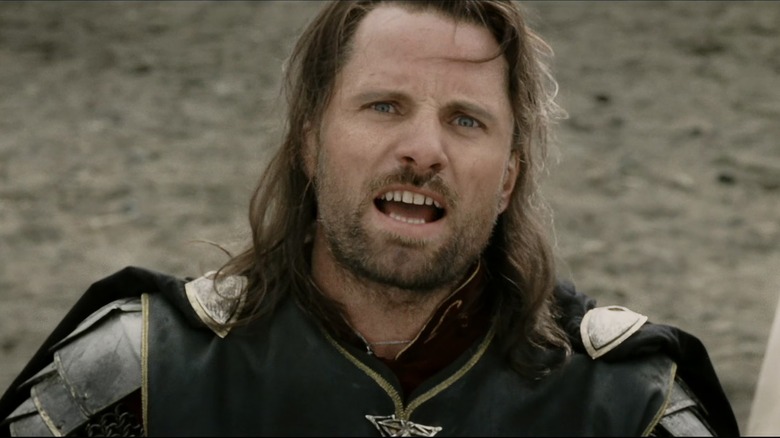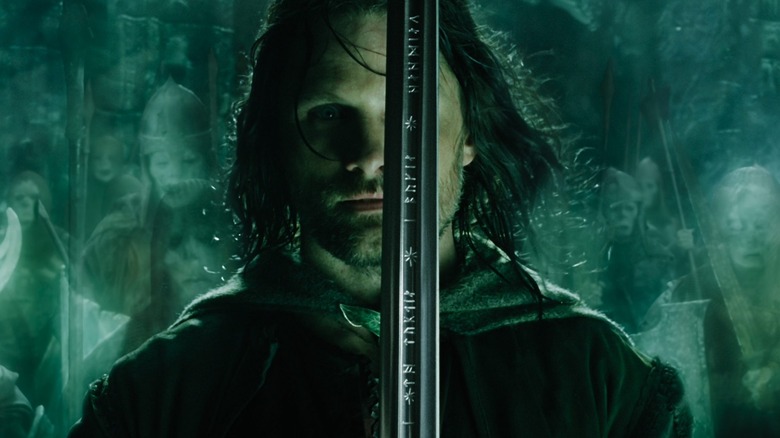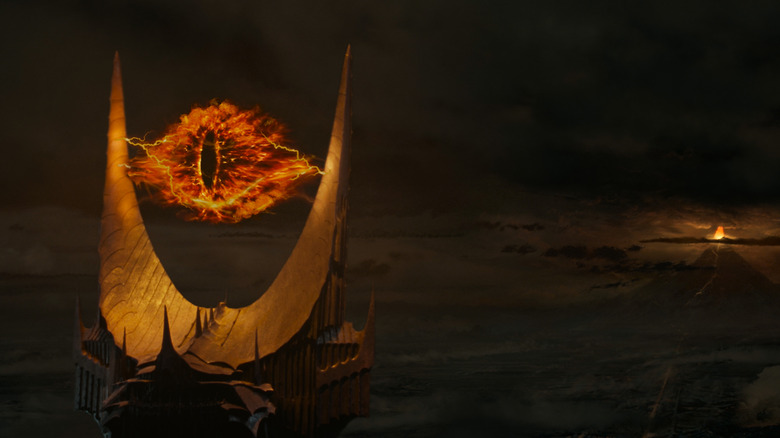Viggo Mortensen Had One Big Problem With The Evolution Of The Lord Of The Rings And The Hobbit
"The Lord of the Rings" is one of the all-time great movie trilogies, and you'd be hard-pressed to come up with many others that managed to maintain the same consistent level of quality throughout all three films. "Toy Story," for instance, is technically no longer a trilogy since the release of "Toy Story 4," and even "Star Wars" had a bit of a drop-off after "The Empire Strikes Back," with the critical consensus not favoring "Return of the Jedi" as much as its two predecessors (even if the word on the street from fans is still that it's the second best "Star Wars" movie).
In the case of "The Lord of the Rings," however, all three films were nominated for Best Picture at the Academy Awards, and the third and final film, "The Lord of the Rings: The Return of the King," actually won — sweeping the Oscars and winning in all ten of the other categories it was nominated in, as well. That doesn't mean everyone, including the film's own cast members, think it was flawless. In fact, Viggo Mortensen, who rose to prominence playing the titular king-to-be, Aragorn, in "Return of the King," sees it and "The Lord of the Rings: The Two Towers" as the beginning of an unsubtle, overly CGI-reliant trend in director Peter Jackson's filmography.
In a 2014 interview with The Telegraph, Mortensen said:
"Peter was always a geek in terms of technology, but once he had the means to do it, and the evolution of the technology really took off, he never looked back. In the first movie ['The Fellowship of the Ring'], yes, there's Rivendell, and Mordor, but there's sort of an organic quality to it, actors acting with each other, and real landscapes; it's grittier."
"The Second Movie Already Started Ballooning ..."
"The Fellowship of the Ring" is a clear favorite for Mortensen when it comes to "The Lord of the Rings" movies. He continued:
"The second movie ['The Two Towers'] already started ballooning, for my taste, and then by the third one ['Return of the King'], there were a lot of special effects. It was grandiose, and all that, but whatever was subtle, in the first movie, gradually got lost in the second and third. Now with 'The Hobbit,' one and two, it's like that to the power of 10."
It's important to consider the context of these comments: Mortensen was sharing them between "The Desolation of Smaug" and "The Battle of the Five Armies," the second and third films in Jackson's "Hobbit" trilogy, which was heavy on CGI and stretched out a single J.R.R. Tolkien book to three movies ("ballooning," indeed). By that time, Jackson had somewhat fallen out of critical favor, with some regarding his continued stint in Middle-earth as a symptom of Hollywood's overall, franchise-obsessed prequel-itis and sequel-itis.
Among other things, "The Return of the King" does contain a scene where Aragorn is completely surrounded by green ghosts reminiscent of the blue ones Jackson put on screen with Michael J. Fox in "The Frighteners." When you think about moments like that — and contrast them with the simple forced perspective and other practical effects Jackson used in "The Fellowship of the Ring" — it's maybe not so hard to see what Mortensen is talking about when he speaks of "The Lord of the Rings" trilogy shifting more toward CGI.
"The Genie Was Out Of The Bottle"
The commercial success of "The Fellowship of the Ring" enabled Jackson to go bigger with effects in "The Two Towers" and "The Return of the King," but whether that is a feature or a bug is up to the viewer to decide. As for Mortensen, he was hoping to see Jackson return to his independent filmmaking roots with a lower-budget movie like his Oscar-nominated 1994 feature, "Heavenly Creatures," which broke him out of his early splatter horror phase and saw him tackling a more human-centered drama. Mortensen said:
"I was sure he would do another intimately scaled film like 'Heavenly Creatures,' maybe with this project about New Zealanders in the First World War he wanted to make. But then he did 'King Kong.' And then he did 'The Lovely Bones' — and I thought that would be his smaller movie. But the problem is, he did it on a $90 million budget. That should have been a $15 million movie. The special effects thing, the genie, was out of the bottle."
After "The Lord of the Rings," Mortensen would go on to collaborate on several films with David Cronenberg and star in dramas like "Green Book." For his part, Jackson did finally move away from big-budget CG effects into the realm of documentary filmmaking. That project about the First World War that Mortensen was talking about would become Jackson's acclaimed "They Shall Not Grow Old." In 2021, Jackson took on the Fab Four as his latest subject in "The Beatles: Get Back."


